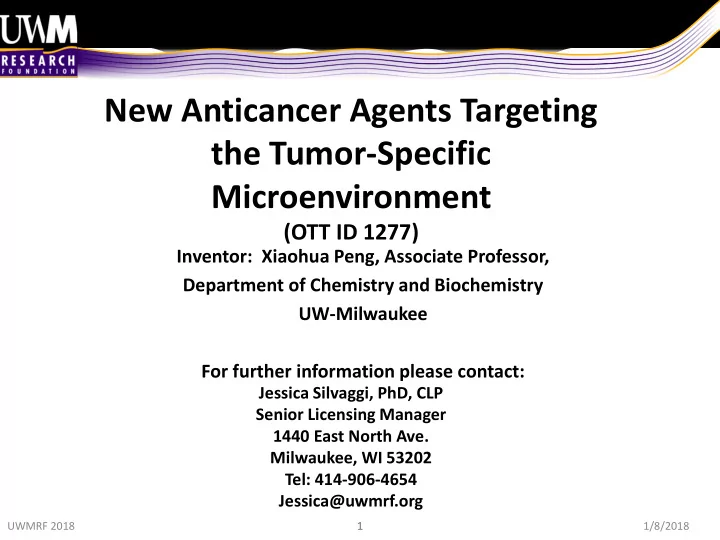

New Anticancer Agents Targeting the Tumor-Specific Microenvironment (OTT ID 1277) Inventor: Xiaohua Peng, Associate Professor, Department of Chemistry and Biochemistry UW-Milwaukee For further information please contact: Jessica Silvaggi, PhD, CLP Senior Licensing Manager 1440 East North Ave. Milwaukee, WI 53202 Tel: 414-906-4654 Jessica@uwmrf.org UWMRF 2018 1 1 1/8/2018
Current Problems with Cancer Therapies ● Goal: Improve the selectivity of cancer therapy ● Problems/Unmet Needs: Severe side effects, attack healthy cells Prodrug approach: drugs in an inactive or significantly less active form, metabolized to active form Previous prodrug approach: low selectivity low levels of activators in necrotic tumor tissue UWMRF 2018 2 1/8/2018
Pro-drugs Targeting Tumor Cells • Prodrugs are only activated by unique features inside cancer cells • Selective release of toxic drug in cancer cells • U.S. Utility Patents Issued – Anti-Cancer Agents: 8,637,490 – Anti-Cancer Agents: 8,962,670 UWMRF 2018 3 1/8/2018
Market Size • The global oncology market is expected to reach $112B by 2020 • Targeted cancer drugs now make up 46% of cancer sales • The Agency for Healthcare research and Quality (AHRQ) estimates that the direct medical costs (total of all health care costs) for cancer in the US in 2014 were $87.8 billion Targeted cancer drug http://www.thepharmaletter.com/article/targeted-cancer-drug-market-set-to-reach-51- billion-by-2015-led-by-pfizer-barriers-to-use-of-oral-cancer-drugs-identified UWMRF 2018 4 1/8/2018
Market Potential Applications for our compounds • Inhibiting cancer cell growth or causing cell death in leukemia, non- small cell lung cancer, colon cancer, breast cancer, and renal cancer cell lines (tested in NCI 60 assays) • Reducing tumor size in animal models for renal cancer cell lines and breast cancer cell lines • Our tumor-targeting prodrug platform approach can be applied to thousands of other drugs UWMRF 2018 5 1/8/2018
High Level of Hydrogen Peroxide in Cancer Cells CANCER CELLS: ● Contain reactive oxygen species (ROS) : hydrogen peroxide and free radicals ● Rapidly divide and grow ● Have increased active metabolism ● Show decreased free radical scavenging enzymes *Prodrugs activated by hydrogen peroxide can selectively kill cancer cells UWMRF 2018 6 1/8/2018
Designing Prodrugs That Target Tumor Cells • Non-toxic until located in cancer cells • Hydrogen peroxide trigger Activation UWMRF 2018 7 1/8/2018
Our Drugs Work in vivo ● They are safe to mice: no obvious toxicity, no weight loss ● Reduce tumor size (breast cancer) ● Drug used during entire treatment UWMRF 2018 8 1/8/2018
Our Drugs Also Shrink Established Tumors Vehicle 850 Compound 2 Tumor size (mm 3 ) 700 550 400 250 100 1 2 3 4 5 6 Week • Compound 2 induces genes involved in apoptosis and cell cycle • P21, P53, Bcl2, and CyclinD1 RNA levels were induced • Microarrays showed genetic modulation in DNA binding, DNA repair, and DNA ligation *Manuscript submitted; related data Wang et al. 2017. EJMC. 133: 197-207. UWMRF 2018 9 1/8/2018
Moving the Program Forward Pharmacological proof of concept (PK/Tox/ADME) • Animal model studies ($500,000) Toxicity test ( ) Xenograft mice model study ( ) Transgenic mice model • Lead optimization ($300,000) *metabolic stability ( ) *oral availability *bio-distribution *function of mechanism: in vivo target selectivity UWMRF 2018 10 1/8/2018
Next Steps Needed Looking for industry partners • Transition to clinical/commercial development • Further funding required • Conducting clinical trials for effective lead compounds • Licensing of our technology Partnering with industry on sponsored research • Applying this platform technique for developing novel pro-drugs UWMRF 2018 11 1/8/2018
In Summary • The Peng lab has designed and synthesized a series of novel ROS- activated aromatic nitrogen mustards which selectively kill tumor cells with minimal effects on normal cells • Mouse xenograph tumor models using breast cancer show tumor prevention and regression with lead compounds • Lead compounds are not prohibitively toxic to normal cells UWMRF 2018 12 1/8/2018
New Anticancer Agents Targeting the Tumor-Specific Microenvironment (OTT ID 1277) Jessica Silvaggi Senior Licensing Manager 1440 East North Ave. Milwaukee, WI 53202 Tel: 414-906-4654 Jessica@uwmrf.org UWMRF 2018 13 1/8/2018
Recommend
More recommend